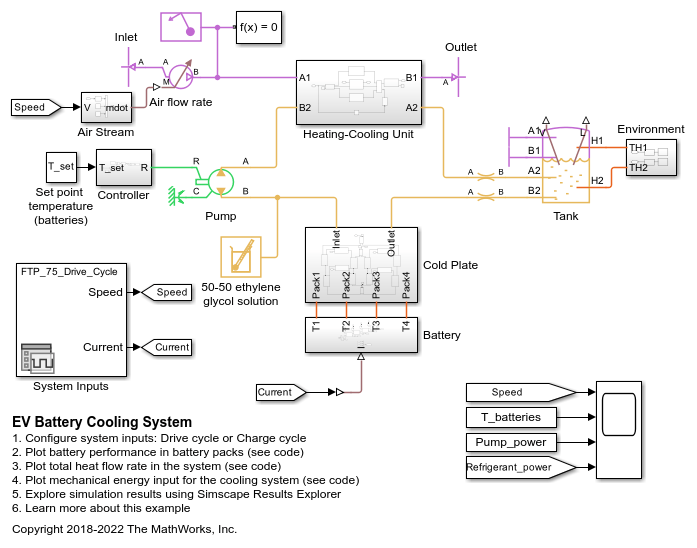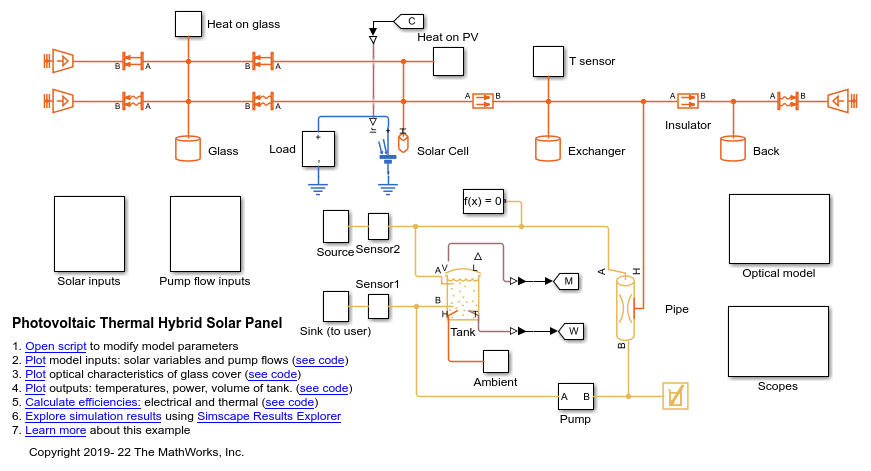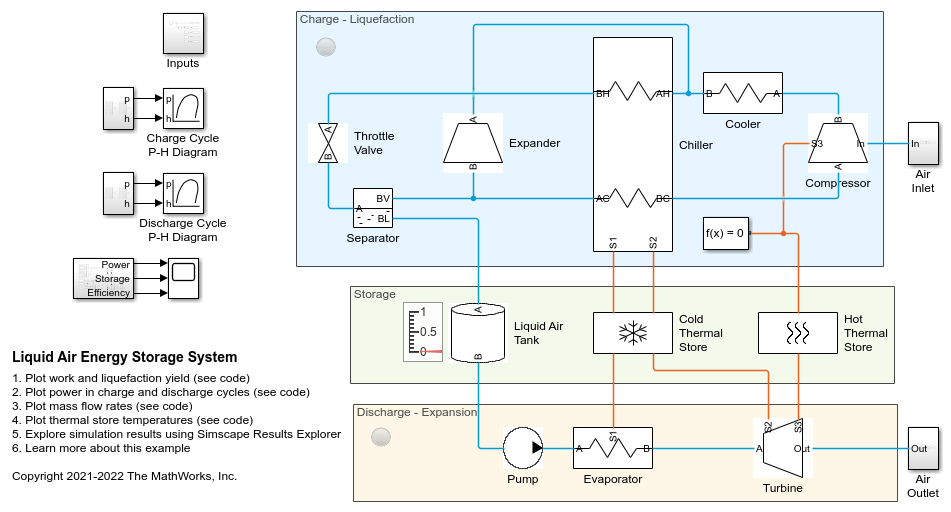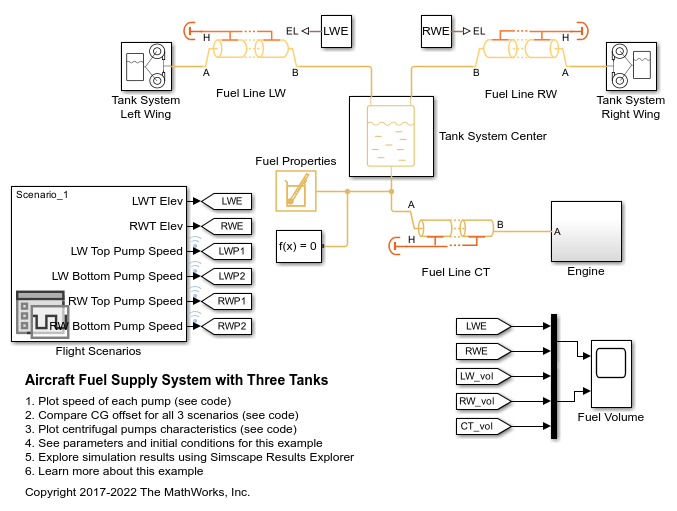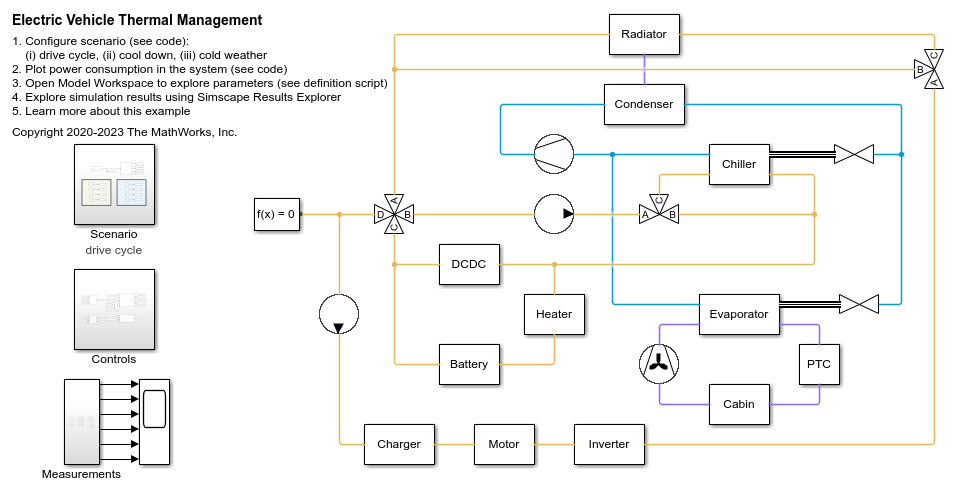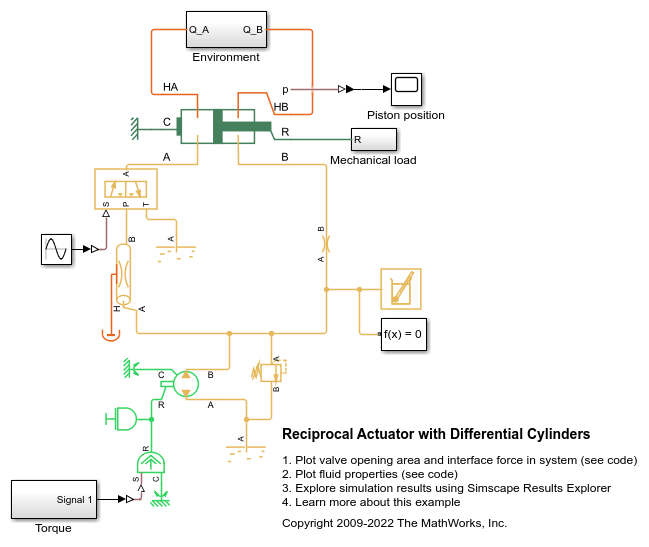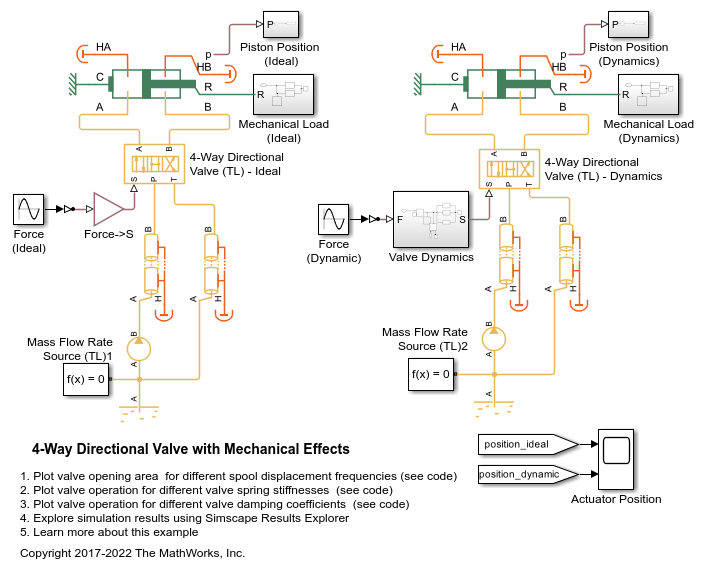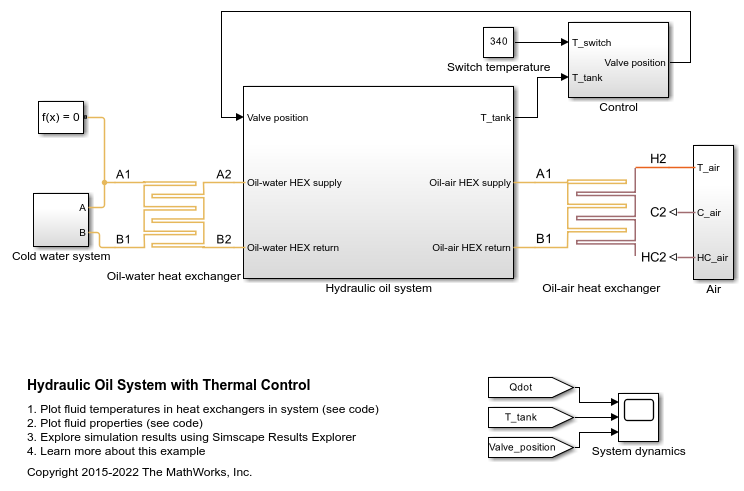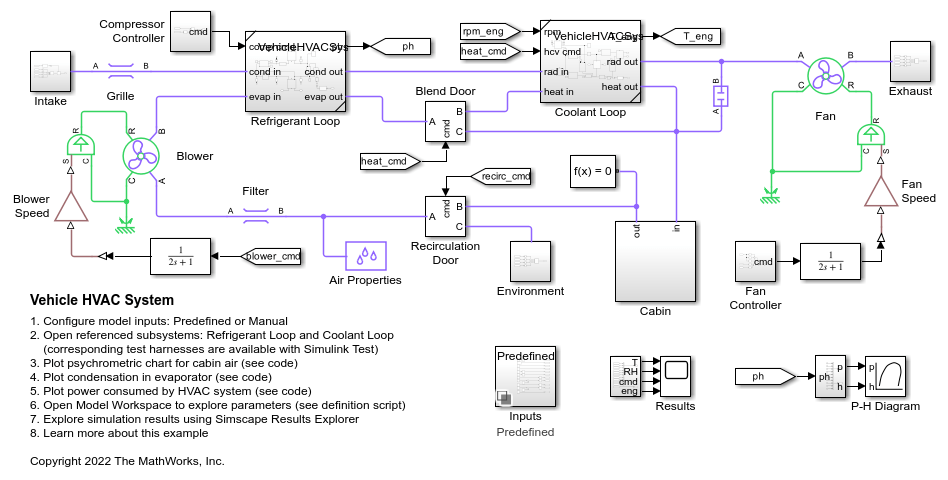Valves and Orifices
Use these blocks to model orifices, valves, valve actuators, and forces associated with valves and orifices in the thermal liquid domain.
Simscape Blocks
Fundamental Valve Components
| Flow Coefficient Parameterized Valve (TL) | Valve with flow area modeled in terms of its Cv or Kv flow coefficient |
| Orifice (TL) | Constant-area or variable-area orifice in a thermal liquid system (Since R2022a) |
Directional Control Valves
| 2-Way Directional Valve (TL) | 2-way directional valve in a thermal liquid network |
| 3-Way Directional Valve (TL) | 3-position directional valve in a thermal liquid network |
| 4-Way 2-Position Directional Valve (TL) | 4-way 2-position directional valve in a thermal liquid network (Since R2024a) |
| 4-Way 3-Position Directional Valve (TL) | Valve for routing flow at the junction of four lines in a thermal liquid network |
| Check Valve (TL) | Check valve in a thermal liquid network |
| Pilot-Operated Check Valve (TL) | Check valve with control port to enable flow in reverse direction |
Flow Control Valves
| Poppet Valve (TL) | Poppet flow control valve in a thermal liquid network |
| Gate Valve (TL) | Gate valve in a thermal liquid system |
| Temperature Control Valve (TL) | Temperature control valve in a thermal liquid network |
Pressure Control Valves
| Counterbalance Valve (TL) | Counterbalance valve in a thermal liquid network (Since R2024b) |
| Pressure Reducing Valve (TL) | Pressure reducing valve in a thermal liquid network |
| Pressure Relief Valve (TL) | Pressure relief valve in a thermal liquid network |
| Pressure Compensator Valve (TL) | Pressure compensator valve in thermal liquid network (Since R2023a) |
Valve Actuators and Forces
| Multiposition Valve Actuator | Multiposition actuator in any fluid domain (Since R2020a) |
| Proportional Valve Actuator | Power-controlled valve actuator in any fluid domain (Since R2020a) |
Topics
- Modeling Directional Valves in Simscape Fluids
Selecting and parameterizing directional control valves in Simscape Fluids.
- Building a Custom Valve
Model a custom valve with orifice blocks.
- Model a Refrigeration Cycle
Model considerations for a closed-loop refrigeration cycle.
Featured Examples
EV Battery Cooling System
This demo shows an Electric Vehicle (EV) battery cooling system. The battery packs are located on top of a cold plate which consists of cooling channels to direct the cooling liquid flow below the battery packs. The heat absorbed by the cooling liquid is transported to the Heating-Cooling Unit. The Heating-Cooling Unit consists of three branches to switch operating modes to cool and heat the battery. The Heater represents an electrical heater for fast heating of the batteries under low temperature conditions. The Radiator uses air-cooling and/or heating when the batteries are operated stably. The Refrigerant system is used for cooling the overheated batteries. The refrigeration cycle is represented by the amount of heat flow extracted from the cooling liquid. The system is simulated under either FTP-75 drive cycle or fast charge scenarios with different environment temperatures.
Photovoltaic Thermal (PV/T) Hybrid Solar Panel
Model the cogeneration of electrical power and heat using a hybrid PV/T solar panel. The generated heat is transferred to water for household consumption.
Liquid Air Energy Storage System
Models a grid-scale energy storage system based on cryogenic liquid air. When there is excess power, the system liquefies ambient air based on a variation of the Claude cycle. The cold liquid air is stored in a low-pressure insulated tank until needed. When there is high power demand, the system expands the stored liquid air to produce power based on the Rankine cycle.
Aircraft Fuel Supply System with Three Tanks
Model an aircraft fuel supply system consisting of three tanks and an engine.
Electric Vehicle Thermal Management
Model the thermal management system of a battery electric vehicle.
Reciprocal Actuator with Differential Cylinders
A double-acting actuator with differential cylinders. The pump output is connected to cylinder B of the actuator while cylinder A of the actuator can be connected to either the pump or the reservoir through the 3-way directional valve. When cylinder A is connected to the pump, pressures at both cylinders become equal. Because of the larger effective piston area in cylinder A, the interface force in cylinder A is larger than that of in cylinder B which causes the piston to extend. When cylinder A is connected to the reservoir, the piston starts to retract. The 3-way directional valve is controlled by a sinusoidal signal to achieve repeating reciprocal motion in the actuator.
4-Way Directional Valve with Mechanical Effects
Compares two 4-way directional valves, one with mechanical components to account for spool mass, valve spring and damper and one without (ideal valve). The input force to both valves is a sine wave. The operation of two valves are compared for different displacement frequencies, valve spring stiffness and damper coefficients.
Hydraulic Oil System with Thermal Control
A hydraulic oil system with a thermal control using Simscape™ Fluids™ Thermal Liquid blocks. The hydraulic oil system consists of an oil storage tank represented by the Tank (TL) block with two inlets, a pump represented by a Mass Flow Rate Source (TL) block, and pipelines represented by Pipe (TL) block.
Electric Vehicle Thermal Management
Model the thermal management system of a battery electric vehicle.
Vehicle HVAC System
Models the heating and cooling system of a passenger car. The cabin is represented as a volume of moist air exchanging heat with the external environment. The blower drives moist air through the evaporator, blend door, and heater core before returning to the cabin. The blend door controls the amount of air flow through the heater core. The recirculation door controls whether air is brought in from the external environment or from within the cabin.
MATLAB Command
You clicked a link that corresponds to this MATLAB command:
Run the command by entering it in the MATLAB Command Window. Web browsers do not support MATLAB commands.

Select a Web Site
Choose a web site to get translated content where available and see local events and offers. Based on your location, we recommend that you select: .
You can also select a web site from the following list
How to Get Best Site Performance
Select the China site (in Chinese or English) for best site performance. Other MathWorks country sites are not optimized for visits from your location.
Americas
- América Latina (Español)
- Canada (English)
- United States (English)
Europe
- Belgium (English)
- Denmark (English)
- Deutschland (Deutsch)
- España (Español)
- Finland (English)
- France (Français)
- Ireland (English)
- Italia (Italiano)
- Luxembourg (English)
- Netherlands (English)
- Norway (English)
- Österreich (Deutsch)
- Portugal (English)
- Sweden (English)
- Switzerland
- United Kingdom (English)
Asia Pacific
- Australia (English)
- India (English)
- New Zealand (English)
- 中国
- 日本Japanese (日本語)
- 한국Korean (한국어)
